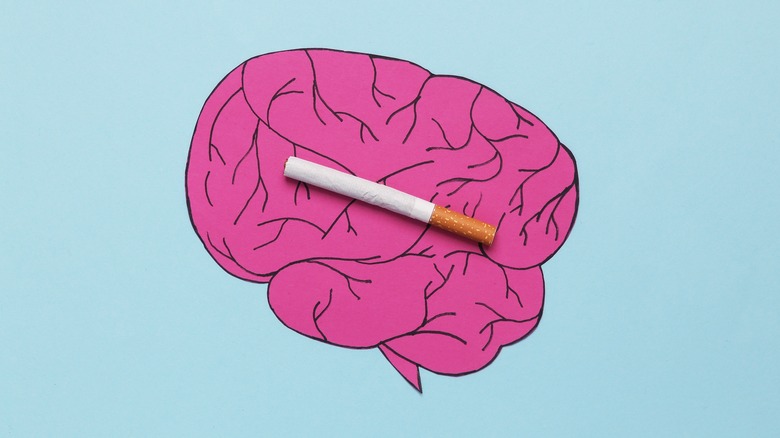Why Is Nicotine So Addictive?
Tobacco use is a worldwide epidemic, claiming the lives of more than 8 million people annually, according to the World Health Organization. Of that number, more than 1 million people each year die as a result of secondhand smoke. Despite the dangers of tobacco use, people continue to use tobacco products, including smokeless products like e-cigarettes. The reason is that the nicotine contained in tobacco products is highly addictive.
Because of nicotine's addictive properties, only about 6% of smokers in a given year are able to quit, according to the National Institute on Drug Abuse. All tobacco products contain nicotine, because nicotine naturally occurs in the tobacco plant itself (via the U.S. Food and Drug Administration). However, certain tobacco products have additives in them that make it even easier for your body to absorb nicotine. In fact, there are some that have the ability to deliver nicotine to the brain in seconds, which makes it that much easier to become addicted.
Nicotine can change your brain
When you use tobacco products, nicotine is absorbed into the bloodstream and travels up to the brain, causing the release of dopamine (via Health and Social Services). The dopamine hit delivers good feelings and, over time, the brain begins to crave that feeling. The more you use tobacco, the makeup of your brain actually changes, increasing the number of receptors for nicotine, which makes quitting much more difficult (via the Mayo Clinic). Additionally, Health and Social Services notes that nicotine can react with the adrenal glands, causing a rush of adrenaline into the body and giving tobacco users a burst of focus and energy.
The addictiveness of nicotine can be measured, according to the National Institute on Drug Abuse, by how reinforcing it is, or how much it drives people to continue using it. Despite not delivering the same high as other drugs such as marijuana or opioids, nicotine continues to be a very reinforcing drug. The continued release of dopamine almost "teaches" the brain to crave tobacco products, and this behavior can be difficult to unlearn. As a result, tobacco products remain in heavy use, with 30.8 million Americans currently smoking cigarettes, according to the Centers for Disease Control and Prevention.
It can be tough to break the habit
Signs of nicotine addiction, according to the Mayo Clinic, include an inability to quit smoking, even when faced with health problems, as well as withdrawal symptoms such as cravings, depression, anxiety, irritability, and even physical symptoms such as constipation and diarrhea. People who are addicted to nicotine find it very difficult to quit, with the World Health Organization reporting that, of the nicotine users who try to give it up, only 4% will succeed without support.
If you are struggling with nicotine addiction, there are a number of things you can try to break the habit, according to the Mayo Clinic. These include nicotine replacement therapies such as a patch, gum, or an inhaler, as well as prescription drugs such as Wellbutrin or varenicline. You should also be conscious of your triggers and devise plans to work around them. For example, if you used to smoke while out at parties or bars, try to have sugarless gum or hard candy on hand to keep your mouth busy and tobacco free. Talk to your doctor to see what the best solution for your nicotine addiction might be and what steps you can take to kick the habit for good.



